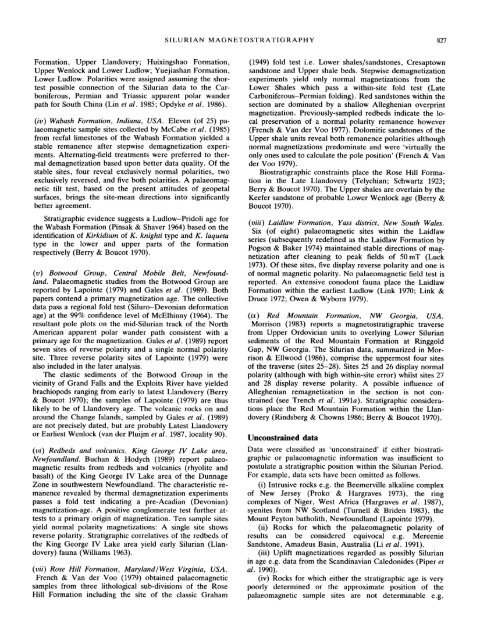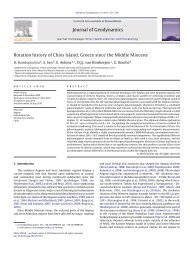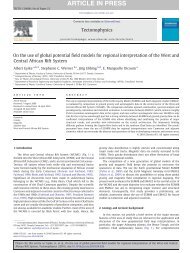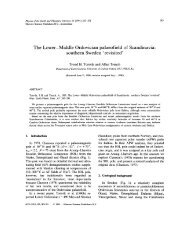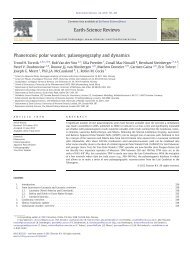Journal of the Geological Society - Earth Dynamics Group @ UiO
Journal of the Geological Society - Earth Dynamics Group @ UiO
Journal of the Geological Society - Earth Dynamics Group @ UiO
- No tags were found...
You also want an ePaper? Increase the reach of your titles
YUMPU automatically turns print PDFs into web optimized ePapers that Google loves.
SILURIAN MAGNETOSTRATIGRAPHY 827Formation, Upper Llandovery; Huixingshao Formation,Upper Wenlock and Lower Ludlow; Yuejiashan Formation,Lower Ludlow. Polarities were assigned assuming <strong>the</strong> shortestpossible connection <strong>of</strong> <strong>the</strong> Silurian data to <strong>the</strong> Carboniferous,Permian and Triassic apparent polar wanderpath for South China (Lin et al. 1985; Opdyke et al. 1986).(iv) Wabash Formation, Indiana, USA. Eleven (<strong>of</strong> 25) palaeomagneticsample sites collected by McCabe et al. (1985)from reefal limestones <strong>of</strong> <strong>the</strong> Wabash Formation yielded astable remanence after stepwise demagnetization experiments.Alternating-field treatments were preferred to <strong>the</strong>rmaldemagnetization based upon better data quality. Of <strong>the</strong>stable sites, four reveal exclusively normal polarities, twoexclusively reversed, and five both polarities. A palaeomagnetictilt test, based on <strong>the</strong> present attitudes <strong>of</strong> geopetalsurfaces, brings <strong>the</strong> site-mean directions into significantlybetter agreement.Stratigraphic evidence suggests a Ludlow-Pridoli age for<strong>the</strong> Wabash Formation (Pinsak & Shaver 1964) based on <strong>the</strong>identification <strong>of</strong> Kirkidium <strong>of</strong> K. knighti type and K. laquetatype in <strong>the</strong> lower and upper parts <strong>of</strong> <strong>the</strong> formationrespectively (Berry & Boucot 1970).(v) Botwood <strong>Group</strong>, Central Mobile Belt, Newfoundland.Palaeomagnetic studies from <strong>the</strong> Botwood <strong>Group</strong> arereported by Lapointe (1979) and Gales et al. (1989). Bothpapers contend a primary magnetization age. The collectivedata pass a regional fold test (Siluro-Devonian deformationage) at <strong>the</strong> 99% confidence level <strong>of</strong> McElhinny (1964). Theresultant pole plots on <strong>the</strong> mid-Silurian track <strong>of</strong> <strong>the</strong> NorthAmerican apparent polar wander path consistent with aprimary age for <strong>the</strong> magnetization. Gales et al. (1989) reportseven sites <strong>of</strong> reverse polarity and a single normal polaritysite. Three reverse polarity sites <strong>of</strong> Lapointe (1979) werealso included in <strong>the</strong> later analysis.The clastic sediments <strong>of</strong> <strong>the</strong> Botwood <strong>Group</strong> in <strong>the</strong>vicinity <strong>of</strong> Grand Falls and <strong>the</strong> Exploits River have yieldedbrachiopods ranging from early to latest Llandovery (Berry& Boucot 1970); <strong>the</strong> samples <strong>of</strong> Lapointe (1979) are thuslikely to be <strong>of</strong> Llandovery age. The volcanic rocks on andaround <strong>the</strong> Change Islands, sampled by Gales et al. (1989)are not precisely dated, but are probably Latest Llandoveryor Earliest Wenlock (van der Pluijm et al. 1987, locality 90).(vi) Redbeds and volcanics, King George IV Lake area,Newfoundland. Buchan & Hodych (1989) report palaeomagneticresults from redbeds and volcanics (rhyolite andbasalt) <strong>of</strong> <strong>the</strong> King George IV Lake area <strong>of</strong> <strong>the</strong> DunnageZone in southwestern Newfoundland. The characteristic remanencerevealed by <strong>the</strong>rmal demagnetization experimentspasses a fold test indicating a pre-Acadian (Devonian)magnetization-age. A positive conglomerate test fur<strong>the</strong>r atteststo a primary origin <strong>of</strong> magnetization. Ten sample sitesyield normal polarity magnetizations: A single site showsreverse polarity. Stratigraphic correlatives <strong>of</strong> <strong>the</strong> redbeds <strong>of</strong><strong>the</strong> King George IV Lake area yield early Silurian (Llandovery)fauna (Williams 1963).(vii) Rose Hill Formation, Maryland~West Virginia, USA.French & Van der Voo (1979) obtained palaeomagneticsamples from three lithological sub-divisions <strong>of</strong> <strong>the</strong> RoseHill Formation including <strong>the</strong> site <strong>of</strong> <strong>the</strong> classic Graham(1949) fold test i.e. Lower shales/sandstones, Cresaptownsandstone and Upper shale beds. Stepwise demagnetizationexperiments yield only normal magnetizations from <strong>the</strong>Lower Shales which pass a within-site fold test (LateCarboniferous-Permian folding). Red sandstones within <strong>the</strong>section are dominated by a shallow Alleghenian overprintmagnetization. Previously-sampled redbeds indicate <strong>the</strong> localpreservation <strong>of</strong> a normal polarity remanence however(French & Van der Voo 1977). Dolomitic sandstones <strong>of</strong> <strong>the</strong>Upper shale units reveal both remanence polarities althoughnormal magnetizations predominate and were 'virtually <strong>the</strong>only ones used to calculate <strong>the</strong> pole position' (French & Vander Voo 1979).Biostratigraphic constraints place <strong>the</strong> Rose Hill Formationin <strong>the</strong> Late Llandovery (Telychian; Schwartz 1923;Berry & Boucot 1970). The Upper shales are overlain by <strong>the</strong>Keefer sandstone <strong>of</strong> probable Lower Wenlock age (Berry &Boucot 1970).(viii) Laidlaw Formation, Yass district, New South Wales.Six (<strong>of</strong> eight) palaeomagnetic sites within <strong>the</strong> Laidlawseries (subsequently redefined as <strong>the</strong> Laidlaw Formation byPogson & Baker 1974) maintained stable directions <strong>of</strong> magnetizationafter cleaning to peak fields <strong>of</strong> 50roT (Luck1973). Of <strong>the</strong>se sites, five display reverse polarity and one is<strong>of</strong> normal magnetic polarity. No palaeomagnetic field test isreported. An extensive conodont fauna place <strong>the</strong> LaidlawFormation within <strong>the</strong> earliest Ludlow (Link 1970; Link &Druce 1972; Owen & Wyborn 1979).(ix) Red Mountain Formation, NW Georgia, USA.Morrison (1983) reports a magnetostratigraphic traversefrom Upper Ordovician units to overlying Lower Siluriansediments <strong>of</strong> <strong>the</strong> Red Mountain Formation at RinggoldGap, NW Georgia. The Silurian data, summarized in Morrison& Ellwood (1986), comprise <strong>the</strong> uppermost four sites<strong>of</strong> <strong>the</strong> traverse (sites 25-28). Sites 25 and 26 display normalpolarity (although with high within-site error) whilst sites 27and 28 display reverse polarity. A possible influence <strong>of</strong>Alleghenian remagnetization in <strong>the</strong> section is not constrained(see Trench et al. 1991a). Stratigraphic considerationsplace <strong>the</strong> Red Mountain Formation within <strong>the</strong> Llandovery(Rindsberg & Chowns 1986; Berry & Boucot 1970).Unconstrained dataData were classified as 'unconstrained' if ei<strong>the</strong>r biostratigraphicor palaeomagnetic information was insufficient topostulate a stratigraphic position within <strong>the</strong> Silurian Period.For example, data sets have been omitted as follows.(i) Intrusive rocks e.g. <strong>the</strong> Beemerville alkaline complex<strong>of</strong> New Jersey (Proko & Hargraves 1973), <strong>the</strong> ringcomplexes <strong>of</strong> Niger, West Africa (Hargraves et al. 1987),syenites from NW Scotland (Turnell & Briden 1983), <strong>the</strong>Mount Peyton batholith, Newfoundland (Lapointe 1979).(ii) Rocks for which <strong>the</strong> palaeomagnetic polarity <strong>of</strong>results can be considered equivocal e.g. MereenieSandstone, Amadeus Basin, Australia (Li et al. 1991).(iii) Uplift magnetizations regarded as possibly Silurianin age e.g. data from <strong>the</strong> Scandinavian Caledonides (Piper etal. 1990).(iv) Rocks for which ei<strong>the</strong>r <strong>the</strong> stratigraphic age is verypoorly determined or <strong>the</strong> approximate position <strong>of</strong> <strong>the</strong>palaeomagnetic sample sites are not determinable e.g.


